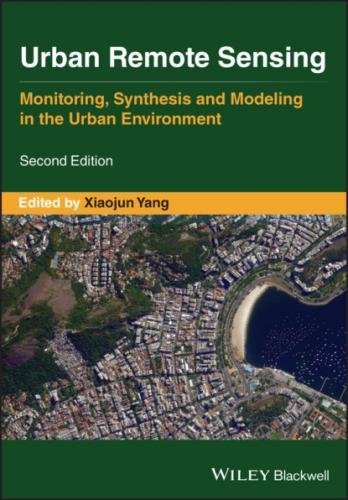Multi‐temporal lidar data analysis facilitates the quantification of built‐up change within urban areas (Vu et al. 2004; Ellis and Mathews 2019) including characterization of types of changes occurring (Teo and Shih 2013; Dong et al. 2018). Although many change detection options exist (too many to cover here), direct differencing of the multi‐temporal DHMs is a common approach. The difference of DHMs (or differential DHM), simply dDHM, is calculated by Eq. (2.2) where t1 indicates the first lidar data acquisition (time 1) and t2 represents the second (time 2):
FIGURE 2.4 Lidar‐derived rasters (1 m spatial resolution) for Detroit, Michigan, 2004: (a) reference map.
Source: OpenStreetMap.
(b) Digital Terrain Model (DTM), (c) Digital Surface Model, and (d) Digital Height Model (DHM).
FIGURE 2.5 Lidar workflow to obtain building‐only volume: raw point cloud data (a), lidar‐derived DHM raster (b), DHM clipped by red building footprints (c); white represents high buildings, black signifies low/ground. The clipped dataset (c) is used for urban built‐up volume (m3 summed per 1 m pixel).
FIGURE 2.6 An example of built‐up change in southeast San Antonio, Texas: 2003 DHM (a), 2012 DHM (b), and difference of DHM (dDHM) (c). For the DHMs (a, b), pixels with higher values are shown with white (i.e. tall buildings) whereas lower values are black (i.e. ground). For the dDHM, red color indicates decreases in height (e.g. demolished buildings, removed trees) between the two years whereas blue denotes increases in height (e.g. new buildings, new or larger tree canopies).
The resulting dDHM (see ahead to Figures 2.6 and 2.7 for examples) rapidly visualizes the extreme changes within the urban environment, namely newly constructed or demolished buildings. The differences identified are then summarized a number of different ways (e.g. amount of built‐up volume increase between t1 and t2, net increase/decrease of built‐up volume). Other approaches attach height and/or volumes attributes to multi‐temporal building footprints for a discrete vector analysis of change. Types of changes (e.g. from vegetation to building, building to demolished building) are characterized using criteria such as roof pitches/slopes, volumetric change metrics, and other parameters (Teo and Shih 2013; Dong et al. 2018). Multi‐temporal lidar analyses though, like any change detection work within remote sensing, are not without challenges and limitations. Specifically, comparison of multiple datasets is difficult when different data acquisition parameters (e.g. point densities, number of returns, time of year), data are pre‐processed and only provided in raster format (i.e. line‐up issues between datasets that must be resolved), lack of available ancillary datasets, and more.
FIGURE 2.7 Citywide built‐up change (shown with dDHM) in San Antonio, Texas, 2003–2013 shown with blue indicating increased height values (i.e. new build‐up) and red decreased height values (i.e. demolished buildings). Vegetation is included in this example.
2.3.2.1 Case Study: San Antonio, Texas
Texas cities have undergone tremendous growth over the past several decades. Unlike other US cities that have witnessed population stagnation or decline (e.g. Detroit, Buffalo), cities such as San Antonio have undergone a 34% increase in population in less than two decades; from 1.1 million residents in 2000 to 1.5 million by 2018 (US Census 2019). Subsequently, such changes are reflected on the urban landscape through residential development (e.g. housing, apartment building) and growth of retail/commercial spaces. Multi‐temporal lidar data provide an ideal geospatial dataset with which to identify such changes in 3D space; in this brief case study, we use lidar‐derived 1 m spatial resolution raster data provided by the Army Geospatial Center collected during the summer months (leaf‐on conditions) in 2003 and 2012.
As an example of 3D change in an urban area, Figure 2.6 shows change in a commercial/retail space in southeast San Antonio between 2003 and 2012. When visually compared, the 2003 and 2012 DHMs (a and b respectively) indicate the removal of a large commercial building at the center and new build‐up in a portion of the space. When differenced via a dDHM, a single dataset can display the change including the type of change. For instance, Figure 2.6c shows the large building from 2003 in red that was demolished by 2012 where new build‐up is shown with blue. Interestingly, the dDHM reveals built‐up “ghosts” (red) that formerly dominated the urban landscape.
At the city‐scale (Figure 2.7), the dDHM highlights extreme (large area) changes well. In this case, many large buildings removed between 2003 and 2012 (red) are visible west/southwest of downtown and along the interstate southeast of downtown. New build‐up (blue) is especially prevalent along the highways in the east/northeast and north parts of the city. At this scale though, much of the change, which covers small areas, is indistinguishable. During this period, much of the northern area shown in Figure 2.7 was developed for residential land use, which can only partially be seen at this scale. In total, the dDHM‐based summation of volumetric change resulted in a net increase of around 27 Mm3 over this nine‐year period. Vegetation is included in this example and becomes apparent along the eastern extent of the analysis area stretching from north‐to‐south where tree canopy increased in size (some of this is a data artifact due to the 2012 data containing more vegetation points). In this way, dDHM calculation will reveal the changes in the urban environment but often not without also unveiling underlying data issues. In this example, because we did not have access to the raw lidar data, line‐up issues identified false changes on the landscape
